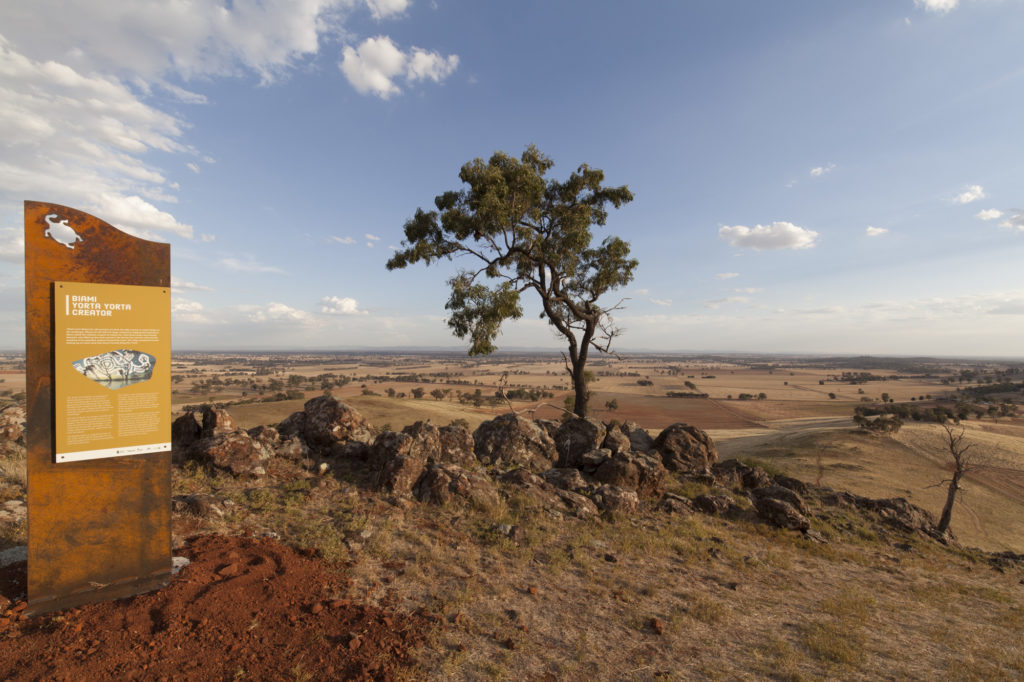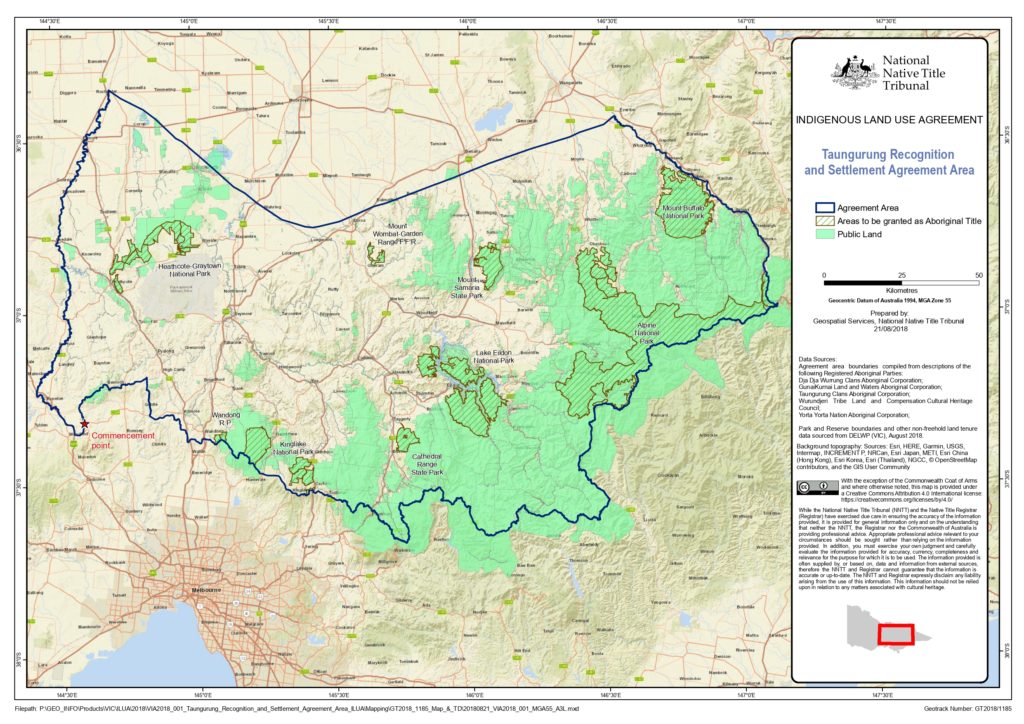
Acknowledgement of Country
The Goulburn Broken CMA acknowledges and respects Traditional Owners and Aboriginal communities and organisations. We recognise the diversity of their cultures and the deep connections they have with Victoria’s lands and waters. We value partnerships with them for the health of people and Country.
We pay our respects to Elders past and present and acknowledge and recognise the primacy of Traditional Owners’ obligations, rights and responsibilities to use and care for their traditional lands and waters.
Traditional Owners
The Goulburn Broken Catchment includes two Registered Aboriginal Parties who represent the interests of Traditional Owners in their respective Country areas: Yorta Yorta Nation Aboriginal Corporation (YYNAC) and Taungurung Land and Waters Council (TLaWC). In Victoria, Registered Aboriginal Parties are determined by the Aboriginal Heritage Council which is comprised of 11 Traditional Owners appointed by the Minister for Aboriginal Affairs.
Both YYNAC and TLaWC are actively involved in cultural heritage management and NRM through joint management agreements and legislative rights to public land. Both organisations work to uphold Yorta Yorta and Taungurung peoples interests with respect to culture and Country.
As valued partners, the YYNAC and TLaWC have been actively involved in the strategy’s renewal to ensure Traditional Owner perspectives and knowledge are integrated. This section details their contribution about connection to Country and opportunities to heal Country from the degradation that has occurred since settlement.
The strategy aims to support YYNAC and TLaWC strategic plans, such as Country Plans and Country Strategies (Fire, Water and so on). Priority actions have been included throughout the strategy to:
- build community understanding, respect and support of Traditional Owner knowledge, culture and values
- promote opportunities for traditional ecological knowledge to guide NRM
- strengthen Traditional Owner influence in decision making
- grow Traditional Owner opportunities to deliver NRM.
Gaka Yawall Ngulla Yorta Yorta woka (Come walk with us on Yorta Yorta Country)
Yorta Yorta peoples have been conserving the landscape and waterways on both sides of the Dungula (Murray River), for thousands of generations. As freshwater people, we maintained and occupied a landscape that contained an abundance of natural resources that were easily accessible through the seasons.

The Dungala is central to Yorta Yorta Country which extends to Cohuna in the west, just outside Albury-Wodonga in the east, to a northerly point in NSW near Finley, and southerly direction reaching almost as far as Nagambie (Figure 5). Yorta Yorta Country contains several significant State and National parks and a Ramsar site in the Goulburn Broken Catchment. It also includes other major waterways, wetlands and tributaries.
The Yorta Yorta Nation consists of 8 different family groups. Yorta Yorta language is spoken by all Yorta Yorta people, including the Kailtheban, Wollithiga, Moira, Ulupna, Bangerang, Kwat Kwat, Yalaba Yalaba and Ngurai-illiam-wurrung clans. The Yorta Yorta Nation retain an undeniable bloodline to original ancestors in the Yorta Yorta region. These bloodlines link our past, present and future to one another, with traditional laws, customs, beliefs and sovereignty intact.
During the pre-colonial period, Australia was an autonomous country. Our social, spiritual, economic and cultural links with the area have never been broken and our relationship and connection to Country has continued since time immemorial.
Our ancestral land and waterways are equally important for the continuity of Yorta Yorta timeless connection with our inherent right. We hold a spiritual connection to the land – it’s our mother. The human spirit is born from our land and creator and returns to it upon death. The land supplies us with everything we need for living. We must look after it so that it will look after us in return. Before colonisation, Yorta Yorta peoples lived in sync with the environment and biodiversity was plentiful.
“We never wanted for anything, everything was free, down to the clear air we breathed, no pollution and clean water, plenty of birds, plant life and animal life. We lived and respected each other’s right to co-exist, to care and practise those rights for our land and water. We resent the system that makes us beggars in our own land.”
Yorta Yorta Elder, Elizabeth Morgan 1927-2009.
Our land, water and resources are important to the wellbeing of Yorta Yorta peoples. Maintaining spiritual connection with our environment and water is central to our culture and identity.
The landscape has been over-cultivated and our native vegetation has been overgrazed.
The degradation of our land has caused soil erosion and a major decline in native vegetation. Invasive weeds and other atrocious plants have increased and cause extensive complications. Water is also being over-extracted from our waterways, wetlands and billabongs, and being used for commodities such as hydroelectric power and irrigation. The quality of the water has become poor and extremely murky because of the high-volume flows and constant water extraction which has caused detrimental slumping and notching of the banks.
Water is core to life for Yorta Yorta peoples. Protecting and managing water is a custodial and intergenerational responsibility. If the cultural and spiritual values of water are sustained by providing water that is sufficient in both quantity and quality, then many other components of our biodiversity will be healthy.
Yorta Yorta peoples have managed and cared for Country since time immemorial, it is not a new concept or a privilege to be managing Country. It is our responsibility. Yorta Yorta must be appropriately resourced to continue this stewardship at all levels from research and policy development through to on-ground caring for Country and service delivery.
Role of Yorta Yorta Nation Aboriginal Corporation
The Yorta Yorta Nation Aboriginal Corporation (YYNAC) is the representative body that provides an interface between governments and Yorta Yorta peoples. YYNAC was established in 1998. It is registered under the Corporations (Aboriginal and Torres Strait Islander) Act 2006 (Cth) to represent the members of the family groups; to make decisions and act on matters of significance to the Yorta Yorta peoples; and to enter into agreements with any person, First Nations, Government agency or authority in relation to the protection of Yorta Yorta Country.
YYNAC is recognised as the Traditional Owner Group Entity for the Yorta Yorta Nation and the recognised entity in agreements with the Victorian Government. YYNAC is also a Victorian Registered Aboriginal Party under the Aboriginal Heritage Act 2006 (Vic) with decision making responsibilities for protecting Aboriginal cultural heritage, and other matters in the area. YYNAC is also a nationally Registered Training Organisation.
YYNAC undertakes a range of functions and activities throughout Victoria and NSW:
- cultural heritage work and projects including the legislative requirements of being a Registered Aboriginal Party
- assistance with the repatriation of Yorta Yorta ancestors
- the operation of the Yenbena Training Centre in Barmah
- maintaining the Yorta Yorta Traditional Owner Land Management Agreement with the State of Victoria over Barmah National Park
- the operation and management of a NRM team (surveying, data collection, works and measures).
Yorta Yorta Whole-of-Country Plan
YYNAC recently released the Yorta Yorta Whole-of-Country Plan for 2021-2030. It is a document built on thousands of years of knowledge and existence in Yorta Yorta traditional boundary.
The Goulburn Broken Regional Catchment Strategy supports the Yorta Yorta Whole-of-Country Plan and hopes to foster partnerships between the YYNAC and other catchment partners to deliver on both strategic plans.
Taungurung – Baan Marram-Nganjin Dilbadin (We protect our water)
Taungurung Recognition Settlement Agreement area (and Registered Aboriginal Party) is bound by the Campaspe River south of Rochester in the west, the Great Dividing Range in the south and extends a long way east of the north-central region. Our Country includes the upper reaches of the Goulburn River and its tributaries, east to the Ovens River and with the northern boundary running between Rochester, Euroa and Everton (Figure 6).

Taungurung buk (people) have managed our land, forests, rivers, wetlands and floodplains for thousands of years. We relied heavily on a healthy Country and our traditional knowledge and management practices shaped the cultural landscape for us to thrive. Despite the ongoing effects of settlement and removal from our lands, our people have maintained their ancestral connection to Country. In the heart of the Taungurung identity, we find our land, forests, rivers, stories and songlines; we are an intrinsic part of Country.
Currently, water management and governance in Victoria excludes our cultural landscape and our traditional knowledge and practices. An unsustainable extraction of resources drives land and water management. Our valued species were often found lining waterways and billabongs. With the increased water demand and the effects of grazing and cropping, the habitat for these species has decreased dramatically. Harmful land-use and water extraction profit from Country’s degradation and have interrupted years of accrued ecological knowledge and practices that were applied to Care for Country.
Before contact, an essential aspect of Taungurung culture was the maintenance and harvest of food and fibre plants found in abundance along floodplains of the Campaspe, Goulburn and Ovens rivers and their tributaries, the mountains and caves of our high Country and in places of habitation and ceremony. These same species have been widely used for generations as knowledge has been passed along family lines throughout the colonial period. In particular, knowledge of our medicines aided our ancestors to survive, both physically and through the continuing practice of Cultural Lore.
The settlement aftermath is one of despair. Our Country is sick and requires attention and healing. As custodians of our land and waters, we feel there is no other time for action. The future of the catchment is at risk due to the accrued impacts of past water management decisions, river flow regulation and land use transformations which have been detrimental to riverine ecosystems.
We still feel the effects and impacts of historical social and political exclusion. Our lack of water rights highlights the flaws of water management in the colonial period and recent water reforms. Today, there is no equitable water use and ownership, and we have been historically denied the opportunity for water to heal Country as well as commercial water that would enable our economic growth. We can’t benefit from water reforms because of constraints to our participation in the water market.
Taungurung has recently gained legal and political recognition to exercise relative self-determination with signing of the Recognition of Settlement Agreement. The agreement allows us to be involved as equal and valued partners in all matters of planning and decision making regarding our land and waters and to look for our economic independence through Caring for Country. Furthermore, it enables opportunity to raise awareness of Taungurung culture as a Nation and redefine our relations with the settler society.
However, competing contemporary land use puts enormous pressure on the ecosystems which are now managed for a different set of values. A context of water scarcity and climate change configure a more complex scenario to incorporate our aspirations. In this competitive scenario, whose water values are prioritised is not merely a technical discussion but a socio-political one, one of environmental justice. The CMAs are in a challenging position where they must navigate State and Basin guidelines, community aspirations and Traditional Owners priorities and perspectives.
The recent droughts and bushfires have violently and brutally impacted our region, and then along came COVID-19. These extreme events are examples of how the future will look if we don’t address issues from the past and present. From our perspective, river flow regulation and the water market have perverse effects on the catchment and the community, not exclusively to Taungurung peoples. Their effects are mostly unobserved because of the delayed effects; and compared to the acute shocks, they get little attention from the community. At the core of the Goulburn Broken Regional Catchment Strategy should be whose water objectives are prioritised and what is genuinely sustainable for our rivers, our catchment and our community.
As stewards of Country, culturally and legally obliged to look after our land, we feel water management not only requires avoiding the mistakes from the past and redistribution of water allocations, but the prioritisation of river health and its connections. Today, the lack of Taungurung water rights is not merely an impediment to control water resources or benefit from them. It is a denial for future Taungurung generations to heal Country, heal traditional knowledge and practices and exercise our culture which is undeniably linked to our land and water.
Role of Taungurung Land and Waters Council
TLaWC is the representative of the Taungurung people, the First Nation and Traditional Owners of the Waring (upper Goulburn River) and its tributaries and lands north of the Great Dividing Range, bounded by the Campaspe River in the west and the Ovens River in the east. The Taungurung people have been the custodians of Country for countless generations, undertaking our cultural obligations to Care for Country and ensuring the health of Country as if it is one of our own kin.
- TLaWC was incorporated in 2003 under what is now the Corporations (Aboriginal and Torres Strait Islander) Act 2006 (Cth).
- In 2009, TLaWC was appointed a Registered Aboriginal Party under the Victorian Aboriginal Heritage Act 2006 (Vic) with respect to the management and protection of Aboriginal cultural heritage.
- TLaWC has entered into a Recognition and Settlement Agreement with the State of Victoria under the Traditional Owner Settlement Act 2010, which recognises TLaWC as the Traditional Owner Group Entity as appointed by the Taungurung.
- The Taungurung Natural Resource Agreement commits the State and the TLaWC to work together in partnership to develop strategies for Traditional Owners’ participation and employment in NRM in Taungurung Country.
TLaWC develops projects for the economic, social and cultural wellbeing of Taungurung people. We liaise with government bodies, private land owners, developers and other stakeholders to support the application of land and water management practices to ensure the health of Country and the protection of cultural heritage.
Taungurung Land and Waters Council planning framework
TLaWC planning framework consists of the whole-of-country government arrangements for their Nation, which are currently in Taungurung policy documents like the Taungurung buk dadbagi, Taungurung Country Plan and the Baan Dhumba-Dji-Ngan Mundak Gunga (water chapter). TLaWC is working on the review of their Country Plan and consequently the development of strategies. References, quotes and links to the current Country Plan will be updated once it has been renewed. This is part of a new emerging Taungurung Cultural NRM strategic framework that allows Taungurung to be the land and water managers of our Country.
The Taungurung buk dadbagi, Taungurung Country Plan communicates Taungurung vision and aspirations for Country, culture and people, to educate and guide those making decisions about Taungurung Country, culture and people.
The Country Plan identifies 6 key areas for action, with aspirations and goals for each:
- identity, recognition and rights
- health and wellbeing
- cultural heritage
- Taungurung traditional knowledge
- caring for our Country
- economic independence.
The TLaWC, with direct participation of Baan Ganalina water knowledge group, have developed a detailed water chapter for the Country Plan – Baan Dhumba-Dji-Ngan Murndak Gunga.
TLaWC supports the priority directions and outcomes defined for the Goulburn Broken Regional Catchment Strategy. In addition, TLaWC has identified priority actions and outcomes, which broadly align with the strategy but articulate Taungurung’s priorities specifically.
While the Taungurung Country Plan is refreshed, the current Taungurung emerging strategic priorities are outlined in Table 4.
Goal: To heal and strengthen knowledge and practice and through its application heal Taungurung culture and Country.
Table 4: Priority actions identified by Taungurung Land and Waters Council that align with the Goulburn Broken Regional Catchment Strategy.
| Action theme | Actions |
|---|---|
| 1. Healing knowledge | • Reactivating Taungurung systems of knowledge and practice transfer and management. • Healing practice: cultural fire and forest gardening (for land management), cultural and environmental flows (for water management), management of culturally important species. • Research programs (including monitoring). |
| 2. Healing Country | • Cultural landscape management: healing and management of important landscapes, places and species. • Reading Country: the assessment and development of cultural objectives to guide management of water, forests and biocultural diversity. • Training in cultural practices and conservation and land management. • Management of parks and reserves in partnership with council and state government. • Private land conservation and management. • Cultural NRM enterprise development, such as agriculture, forestry and fisheries. • Contract services on pubic and private land. |
| 3. Governing Country (embedding Taungurung knowledge and practice). | • Activation of legal rights in the Aboriginal Heritage Act 2006 (Vic), Traditional Owner Settlement Act 2010 (Vic). • Supporting development and revision of government legislation, regulations, local laws, plans, strategies, policies and procedures. |
TLaWC will continue working as equals with other catchment partners, following the principles of self-determination enabling 2 major outcomes:
- Develop two-way capacity between catchment partners and Taungurung Nation to apply on-Country knowledge and practice in contemporary settings.
- Taungurung are managing and governing our Country.
Show your support
Pledge your support for the Goulburn Broken Regional Catchment Strategy and its implementation.



